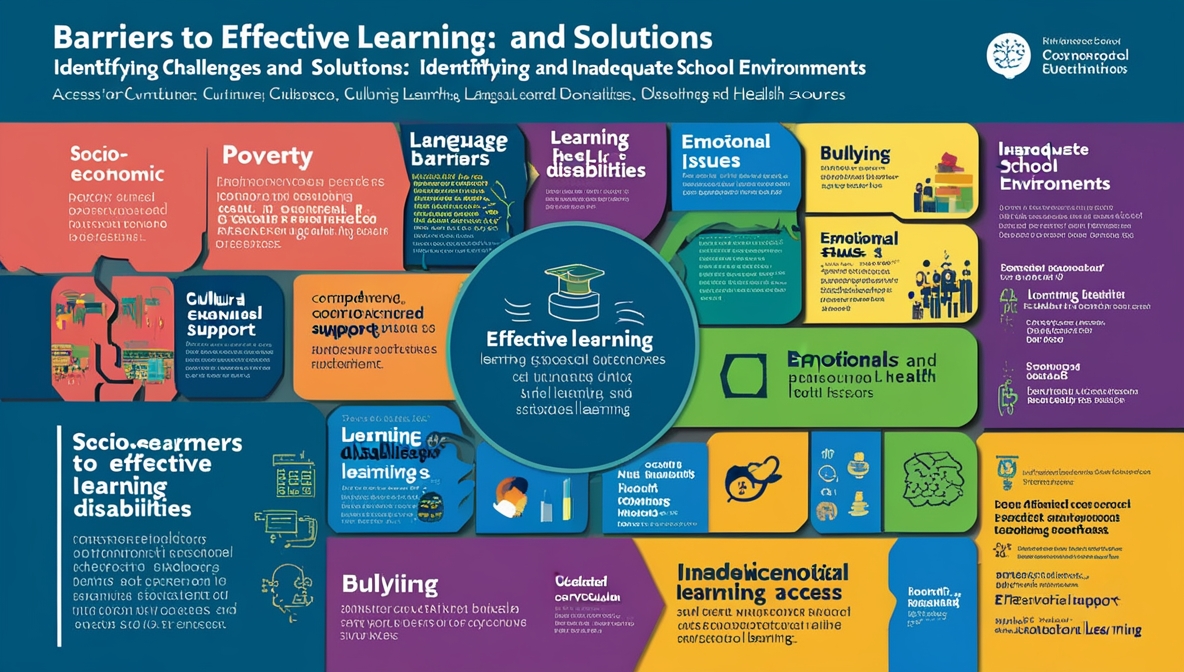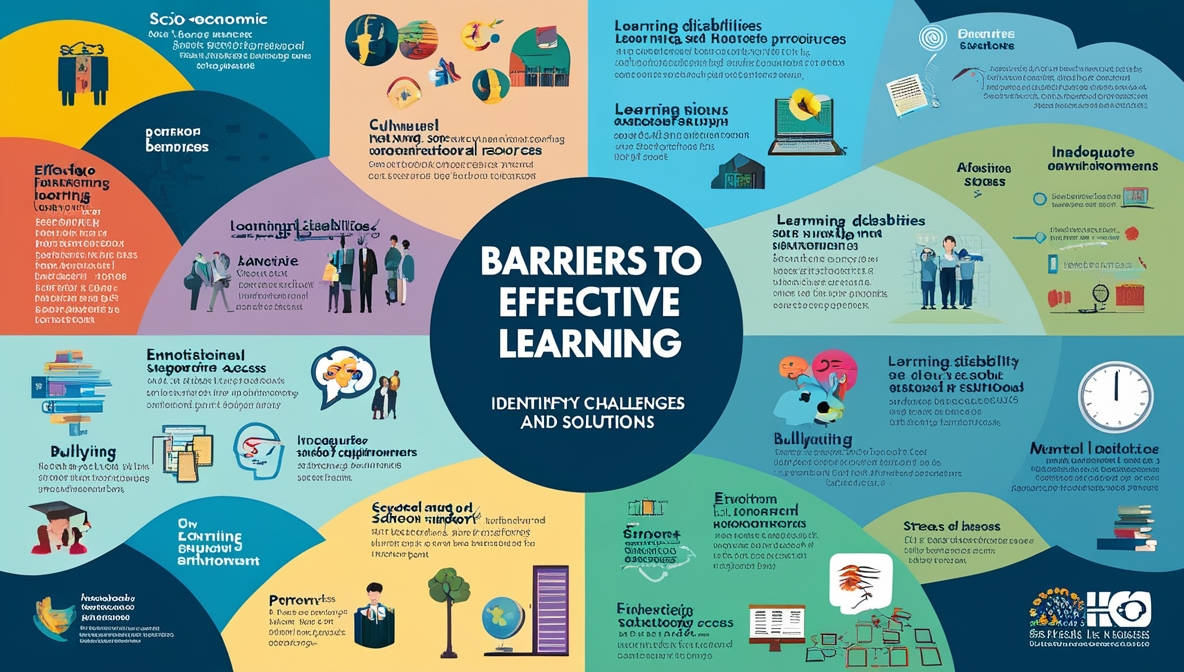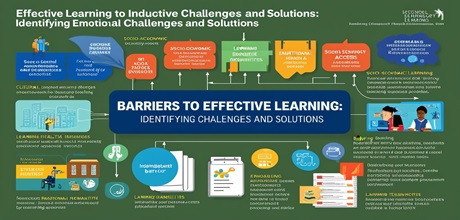Introduction
Barriers to Effective Learning always been an important issue which must be studied. Effective learning is crucial for the personal and academic development of students. However, various barriers can hinder this process, leading to suboptimal educational outcomes. Understanding these barriers is the first step in addressing them, ensuring that all students have the opportunity to succeed. This article explores the primary barriers to effective learning, their impact on students, and strategies to overcome them.

1. Socio-Economic Barriers
Socio-economic status significantly influences students’ access to quality education and learning resources.
- Poverty: Students from low-income families often lack access to essential resources such as books, technology, and extracurricular activities. Poverty can also lead to poor nutrition, inadequate healthcare, and unstable living conditions, all of which negatively impact learning.
- Limited Parental Support: Parents in low-income families may work multiple jobs or lack the educational background to support their children’s learning effectively. This can result in a lack of homework assistance, fewer educational activities at home, and limited engagement with the school.
2. Cultural and Language Barriers
Cultural differences and language proficiency can create significant obstacles to effective learning.
- Language Proficiency: Students who are not fluent in the language of instruction may struggle to understand lessons, participate in class discussions, and complete assignments. This language barrier can lead to lower academic achievement and reduced self-confidence.
- Cultural Differences: Different cultural backgrounds can result in varying educational expectations, communication styles, and values. Students may feel alienated if the curriculum and teaching methods do not reflect their cultural experiences.

3. Learning Disabilities and Special Needs
Students with learning disabilities or special needs face unique challenges that can impede their educational progress.
- Undiagnosed Disabilities: Many students with learning disabilities remain undiagnosed, leading to a lack of appropriate support and accommodations. Without proper identification and intervention, these students may struggle significantly in the classroom.
- Inadequate Support Services: Even when disabilities are diagnosed, schools may lack the necessary resources to provide effective support. This includes specialized teaching staff, tailored instructional materials, and assistive technologies.
4. Emotional and Mental Health Issues
Emotional and mental health problems can severely impact a student’s ability to learn effectively.
- Stress and Anxiety: High levels of stress and anxiety can impair concentration, memory, and overall cognitive function. Students may become disengaged and struggle to keep up with their studies.
- Depression: Depression can lead to a lack of motivation, energy, and interest in school activities. Students with depression may have difficulty attending school regularly, completing assignments, and participating in class.

5. School Environment and Classroom Dynamics
The physical and social environment of the school and classroom plays a crucial role in effective learning.
- Bullying and Peer Pressure: Bullying and negative peer pressure can create a hostile learning environment, leading to absenteeism, low self-esteem, and academic underperformance.
- Teacher-Student Relationship: Positive relationships between teachers and students are essential for effective learning. Teachers who are supportive, approachable, and empathetic can significantly enhance students’ motivation and engagement.
6. Curriculum and Instructional Methods
The design of the curriculum and the instructional methods used can either facilitate or hinder effective learning.
- Outdated Curriculum: An outdated or irrelevant curriculum may fail to engage students or meet their educational needs. It is essential to have a curriculum that is current, comprehensive, and aligned with students’ interests and future career paths.
- Ineffective Teaching Methods: Traditional, one-size-fits-all teaching methods may not address the diverse learning styles and needs of students. Innovative and student-centered approaches, such as differentiated instruction and project-based learning, are more effective in engaging students.
7. Technological Barriers
In today’s digital age, access to technology is essential for effective learning.
- Digital Divide: The gap between students who have access to technology and those who do not can lead to significant disparities in educational outcomes. Students without access to computers, the internet, and other digital tools are at a disadvantage in a technology-driven learning environment.
- Lack of Digital Literacy: Even when technology is available, students and teachers may lack the skills to use it effectively. Digital literacy training is crucial for maximizing the benefits of educational technology.

Strategies to Overcome Barriers to Effective Learning
- Addressing Socio-Economic Barriers:
- Schools can implement programs that provide free or reduced-cost meals, school supplies, and access to extracurricular activities for low-income students.
- Community partnerships and funding initiatives can help bridge resource gaps and support disadvantaged students.
- Supporting Cultural and Language Diversity:
- Schools should adopt culturally responsive teaching practices and materials that reflect the diverse backgrounds of their students.
- Providing language support services, such as English as a Second Language (ESL) programs, can help non-native speakers improve their language skills and academic performance.
- Supporting Students with Disabilities:
- Early identification and intervention are crucial for supporting students with learning disabilities. Schools should have robust screening processes and provide appropriate accommodations.
- Specialized training for teachers and access to resources such as assistive technology can enhance the learning experience for students with special needs.
- Promoting Mental Health and Well-Being:
- Schools should provide access to mental health resources, such as counseling services and stress management programs.
- Creating a supportive and inclusive school climate can help reduce stress and anxiety among students.
- Creating a Positive School Environment:
- Anti-bullying programs and policies are essential for creating a safe and supportive learning environment.
- Building strong, positive relationships between teachers and students can enhance engagement and motivation.
- Innovating Curriculum and Instructional Methods:
- Regularly updating the curriculum to reflect current knowledge and skills is essential for maintaining relevance and engagement.
- Adopting student-centered teaching methods, such as differentiated instruction and project-based learning, can address diverse learning needs and styles.
- Bridging the Technological Divide:
- Providing access to digital tools and resources for all students is crucial for equitable learning opportunities.
- Training programs for teachers and students on digital literacy can enhance the effective use of technology in education.
Conclusion
Addressing the barriers to effective learning is essential for ensuring that all students have the opportunity to succeed. By understanding and addressing socio-economic, cultural, and language barriers, supporting students with disabilities, promoting mental health and well-being, creating a positive school environment, innovating curriculum and instructional methods, and bridging the technological divide, schools can create a more equitable and supportive learning environment. Overcoming these barriers requires a collaborative effort from educators, parents, communities, and policymakers to provide the necessary resources and support for all students.

priligy seratonin Rabeprazole Rabeprazole Rabeprazole may decrease the excretion rate of Cisplatin which could result in a higher serum level
What¦s Taking place i’m new to this, I stumbled upon this I’ve found It absolutely useful and it has helped me out loads. I’m hoping to contribute & aid different customers like its helped me. Great job.
Thanks for any other wonderful article. The place else may just anyone get that kind of info in such an ideal method of writing? I have a presentation subsequent week, and I am at the search for such info.
I got what you mean ,bookmarked, very decent internet site.